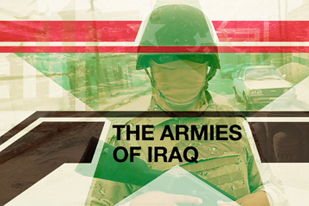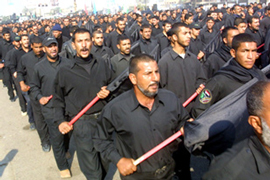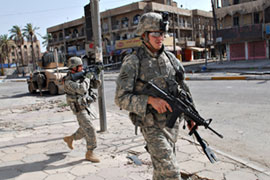Iraq’s many armies
Al Jazeera examines the armed groups in the country and the influence they wield.

 |
Four years ago the fighting in Iraq was just beginning. The armed group al-Qaeda in Iraq did not even exist and Sunni and Shia groups were working together against the US-led forces.
Three years ago, sectarian divisions escalated into a battle some believe has reached civil war proportions.
Now the fighters have turned against each other.
This year has seen Shia infighting on the streets of Iraqi cities such as Karbala and Sunni armed groups fighting to keep al-Qaeda out of their regions.
In a series of reports, Al Jazeera’s Hoda Abdel Hamid looks at the new reality of Iraq’s many armies.
Part One – Sunni armed groups
Sunni armed groups are a complicated web of alliances of Iraqi nationalists, Islamists, former Iraqi army officers and a few Baathists.
For the past four years, the groups have become better organised and more popular among disaffected Sunnis. They see them as a legitimate resistance which also protects civilians from foreign troops and Shia militia death squads.
These days most of the Sunni fighters are Iraqis, and that means the US and Iraqi governments have no choice but to talk to them.
Sources say negotiations are under way, but until Sunni fighters feel their role in the future is recognised they are unlikely to give up their arms.
Part Two – Shia militias
 |
| The Mahdi Army is said to have more than 60,000 militiamen [AFP] |
The conflict between Iraq’s Shia rivals has been ongoing since 2003. The Jaish al-Mahdi, or Mahdi Army, is loyal to Shia leader Muqtada al Sadr. Said to have 60,000 men in its ranks, it is by far the biggest militia in Iraq.
Its rival, the Badr organisation, is the military wing of the Supreme Islamic Iraqi Council, previously known as the Supreme Council for the Islamic Revolution in Iraq. This influential Shia party was formed in Iran during the presidency of Saddam Hussein and its leaders were exultant after the US invasion.
Part Three – Iraq’s security forces
In the remote desert areas of Iraq, US soldiers are training Iraqi recruits to form the nation’s new army and police force.
But outside the cocoon of a training camp, the newly graduated security forces must tackle one of the most challenging environments in the world.
The US is currently allied with some tribes in its fight against al-Qaeda. Incorporating Sunnis would ease some of the sectarian tensions.
But the main question remains: When will the security forces be really able to deal with the challenges of Iraq?
Click here to watch Part Three
Part Four – The US army
 |
|
The presence of its troops in Iraq is a |
They were supposedly welcomed as liberators who would bring freedom and democracy to Iraq.
But the most powerful army in the world was not ready for handmade road-side bombs that have killed hundreds of soldiers so far and maimed thousands more.
It blamed all the attacks in these early stages on al-Qaeda and disgruntled members of Saddam’s former government.
But now, on the eve of the report by General David Petraeus, head of US forces in Iraq, into the success of the recent troop “surge”, the US presence in Iraq is already at the heart of the presidential debate in the US and withdrawing or staying has become a national debate.
Part Five – Al-Qaeda
The Bush administration is building its new case to stay in Iraq as a war against al-Qaeda.
However, it is not the largest group fighting today, nor is it the one that carries out most attacks – only 15 per cent in the first half of 2007 according to the US military.
However, it is behind the vast majority of devastating car bombs and suicide attacks which fuel the sectarian war.